
Andrew B. Myers
In April, six months after her family sold the newspaper it had controlled for eight decades to Amazon founder Jeff Bezos, Washington Post publisher Katharine Weymouth walked onstage in the paper’s auditorium to reverse what had been the signature strategy of her six years at the helm. Since she was named publisher in February 2008, a year the newspaper division of The Washington Post Company declared a loss of $193 million, Weymouth had sought to codify the Post‘s identity as a paper “For and about Washington.” While touted as a strategy to leverage the Post‘s brand of national politics reporting in the digital era, “For and about Washington” was, in the grand tradition of Beltway wordsmithing, a phrase meant to put a positive spin on a period of retrenchment.
As a practical matter, “For and about Washington” meant the Post no longer covered stories beyond its circulation area unless they had a direct link to political Washington or a federal government interest. Exceptions were made for impossible-to-ignore events, like school shootings and other catastrophes, but all domestic bureaus were closed and correspondents were called home. Digital growth was certainly a goal, but the deeper logic of the strategy was that the relative value of a print subscriber trumped that of a digital subscriber. Print continued to provide the vast majority of the paper’s revenue, and newsroom employees were told repeatedly by Weymouth and her deputy, Post president and general manager Steve Hills, that preserving this revenue stream was the organization’s central priority and hope for continued solvency. Digital growth was encouraged to the extent that it fit with the goal of continuing to be the dominant news outlet in the DC region. In fact, the Post achieved impressive digital growth and a major increase in its national audience under this strategy. But it was all achieved under the banner of narrowing ambitions, and no amount of Pulitzer Prizes or popular new blogs or experimental infusions of digital stem cells could make up for this paradox.
At the time of the sale to Bezos, Donald Graham, Weymouth’s uncle and the chairman of The Washington Post Company, explained that he and his niece felt unsure of the direction in which to take the paper, or how to reverse years of declining revenues. He had approached Bezos as a buyer, he said, because the billionaire could offer deep pockets, a digital brain, and, between the two, a way forward.
At some point, the newspaper that brought down a president bowed out of the competition to be the best newspaper in the country.
Now a Bezos employee, Weymouth’s task onstage that April day was to explain to the newsroom that the new way forward was effectively the opposite of the course she had charted. According to a number of people who heard the talk, Weymouth recounted the paper’s efforts under her “For and about Washington” strategy before announcing that the Post was now “pivoting” to a strategy that focused on dramatically building its national and international audience. She pumped her fist in the air for emphasis and declared, “This is the number one priority for the entire company.”
Later in her presentation, Weymouth displayed a chart of the Post‘s Web metrics, with time plotted on the horizontal axis but no numbers on the vertical axis. (The famously secretive Amazon uses such charts to show trends without revealing its sales numbers.) The chart tracked unique visitors and pageviews quarter by quarter starting in 2009. The trend line crested slowly toward a peak at the height of the 2012 presidential election, then continued through peaks and valleys until April, the date of the presentation. From there, the line shot upward into the Post‘s newly imagined future, quadrupling its current Web traffic and nearly breaking the bounds of the number-free Y axis.
Weymouth’s graph was clearly rhetorical, but the Post has recently become a place where rhetorical concepts are bandied about with excitement and fervor. Editors and reporters talk about the Post becoming a “global” paper. They say that the Post will create a news “bundle” that will repackage all the elements of the print newspaper in a way that readers will pay for in digital form. Using tablets and other devices, Bezos aims to recreate the intimate, cohesive, and somewhat linear consumption experience of old media in a way that makes sense for digital. The newsroom has also been told that the paper will cultivate an audience of 100 million unique visitors. Or paid digital subscribers. One hundred million something. They say that, unlike traditional newspaper publishers with their notions of tens of thousands or hundreds of thousands, their new owner thinks in terms of hundreds of millions. I asked editor Marty Baron why the 100-million number kept coming up in my conversations. What did it refer to? “We don’t have a set goal for a hundred million of anything, okay?” he told me. “We just want to grow, that’s all. There’s a desire to increase our number of unique visitors by a very significant degree.”
Given this rather loose mingling of the rhetorical and the actual, of the far horizon and the near-term, it’s not surprising that the mood at the paper is a mix of excitement and confusion. By the time of Weymouth’s town-hall event in April, the Post had already begun to increase staff after a decade of layoffs and buyouts. The hires, aimed at Weymouth’s newly acquired goal of expanding the national audience, were spread across a mix of aggregation projects, blogs, and digital opinion columns, as well as more traditional reporting roles, though the common theme of all the hires was “digital sensibility,” as Baron likes to say.
One reporter told me of the inevitable confusion among the staff, given Weymouth’s sudden push for a strategy of expansion that is “directly contrary” to the previous one of narrowing the paper’s focus. “The pendulum swung all the way over and now it’s swinging all the way back again, without anyone ever saying how that came to be or why we’re doing this other than that we need more traffic,” he said. “Everyone’s thrilled that we’re hiring again, and hiring really good people for the most part. But it’s not clear to the rank and file how this comes together into a vision for what we want to do and what we want to be. That’s been the problem for 15 years.”
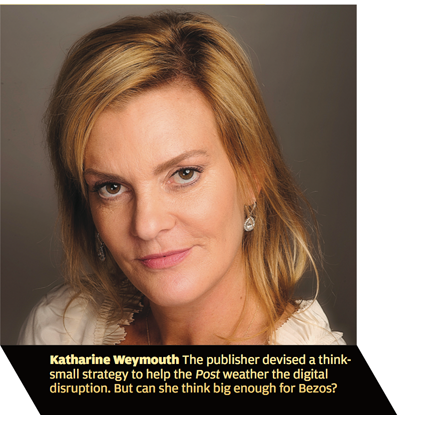
An editor added: “I think Bezos wants us to be everything for everyone, the same way Amazon is.” Like many people interviewed for this article, the editor was granted anonymity to allow him to speak candidly.
Despite the confusion, most everyone agrees that the complexities of expansion are a far better problem to have than those in the years of retreat. “In the old times,” said Cameron Barr, the national editor, referring to a period that ended less than a year ago, “I used to militate against the word ‘still.’ It would come out of people’s mouths all the time and it drove me crazy. ‘We still have great reporters. We still can do great journalism. We’re still The Washington Post.’ I had a jihad against the word ‘still,’ because implicit in that word is the idea that we are totally screwed. But now you don’t hear the word ‘still.’ ”
In the outside world, reaction to the sale split into two groups: those who couldn’t believe that the Grahams would sell the Post, and those who couldn’t believe that a visionary entrepreneur like Jeff Bezos would want anything to do with a newspaper. Inside the Post, the dominant emotion was shock at the Graham family’s imminent departure. Don Graham, in particular, had served as an institutional father figure to thousands of journalists over the years–a kind millionaire who wrote personal notes to reporters about their high school volleyball write-ups and yearlong investigations. He was, by nearly all accounts, a gentleman.
But owning a newspaper is no longer a gentleman’s game. And sadness at the fact that the Post would cease to be “Don’s paper” gave way in the newsroom to the wicked thrill of casting their lot with a man who had made tens of billions of dollars ripping industries apart and remaking them; a man preternaturally competitive even by CEO standards who, according to Brad Stone’s history of Amazon, The Everything Store, told his employees to go after small book publishers “the way a cheetah would pursue a sickly gazelle.”
That this man purchased The Washington Post has the potential to be one of the more significant events in the history of modern American journalism. At some indiscernible point in the last 10 to 15 years, the Post, the newspaper that brought down a president, bowed out of the competition to be the best newspaper in the country and entered into a rivalry with its own past. The paper still did great journalism, but The New York Times became the country’s only outlet with the ambition and the resources to cover the world with depth and intelligence.
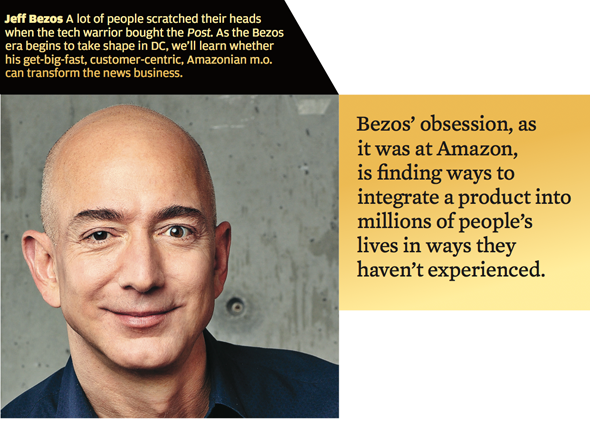
Then $250 million changed hands, and the paper that bowed out was suddenly captained by the digital-era equivalent of Alexander the Great. And not only that, but it instantly became the only member of an industry facing massive digital transformation to be owned by a man who had wrought that transformation–and who had the money to do it again. It went from being a newspaper in retreat to being the only legacy media company in America that can consider itself a technology property.
The Post is once again hungry to be a dominant force in American journalism, and the newsroom senses that the Graham era has been sealed off behind them. The only way out is to move forward. “I think Bezos is giving us a chance to show what we would have done if we had had that runway all along,” one editor said. “If we don’t figure it out, I would not blame the owner for replacing all of us.”
Listen to what Bezos says, or watch where he puts his money and directs his focus, and you can see how he’s starting to overlay the brilliance of Amazon onto the scaffolding of The Washington Post. The journalism isn’t what he plans to revamp, or necessarily invest significant new funds in–the new hires notwithstanding–at least initially. His main focus is the pipeline: reaching the maximum number of customers by putting the Post‘s journalism in a package (a tablet, a mobile site) that will draw the greatest number of readers. As it has been with Amazon, his obsession at the Post is finding a way to integrate a product into millions of people’s lives in a way they haven’t yet experienced.
The seeds of this vision were evident in Bezos’ first visit to the Post in early September 2013, one month prior to the official change of ownership last October. Throughout two days of meetings, Bezos worked to reassure journalists that “the values of the Post don’t need changing,” while at the same time indicating that this would be a very different era at the paper–one focused on the kind of growth and obsession with the customer that have defined Amazon. The unstated purpose of Bezos’ visit was to convince the Post newsroom, its readers, and the wider media world that these two cultures were compatible.
Throughout his visit, Bezos repeatedly made reference to a “new golden era” at the paper. He had breakfast with the iconic investigative reporter Bob Woodward, and took notes as Woodward read from a 14-point memo detailing his advice on matters like harnessing the reporting capacity of the newsroom. At a lunch meeting with about 20 senior editors, Cameron Barr, the national editor, asked Bezos what his sense was of the Post‘s potential audience: “Was it the United States? Was it the English-speaking world?” Bezos indicated that it was the English-speaking world.
At the climax of the visit, Bezos took the same stage Weymouth would take in April and addressed the assembled newsroom. A 92-year-old Ben Bradlee, the Post‘s executive editor during its former golden era, sat in the front row, along with his successor, Leonard Downie Jr., who had expanded the newsroom to more than 1,000 employees before initiating the cutting that would eventually bring it down to around 600.
Bezos spoke without notes in a Q&A session that ran more than an hour. Throughout his talk, he displayed an uncanny attunement to the anxieties of the assembled reporters and editors. He encouraged them to cover both Amazon and himself aggressively, explaining that he was comfortable simultaneously running a secretive company and owning a newspaper, because he believed that “powerful minds can contain powerful inconsistencies.” He said the Post‘s customers should be readers, not advertisers; that the print paper was an “evolved,” “important” product; and that both the local and national missions of the Post were not only compatible but essential. He said that continued cutting would only lead to irrelevance, that the Post would have to work to cultivate a younger audience, and that success meant growth. “What has been happening over the last few years can’t continue to happen,” he insisted. “All businesses need to be young forever. If your customer base ages with you, you’re Woolworth’s.” He said that he would work to make the Post a “daily ritual” that readers would pay for–in effect promising to take his new employees on a quest for the holy grail of digital-era journalism. He offered to be their partner in returning the Post to its former dominance: “It is super clear to me already that people are eager for a golden era . . . . What it means we still need to figure out.”
The Post journalists were ready to compete, and Bezos was offering them the mandate and the resources to do that. One word in particular from Bezos’ visit that reporters and editors latched onto was “runway,” the idea that he would encourage and fund experimentation, and even failure, on the way to success. He told them that he was “stubborn on vision, but flexible on detail.”
After the visit, Bezos, who declined to be interviewed for this article, returned to Seattle and the newsroom began adapting wish-list items that had been accumulating for years to the vague contours of the new owner’s upbeat vision. Baron conducted a series of brainstorming sessions in which he welcomed top editors from across the newsroom to the “dream factory.” What emerged from these sessions was compiled into a list of about three-dozen new ideas that included expansions of successful digital franchises, like Chris Cillizza’s politics blog The Fix and Ezra Klein’s Wonkblog (Klein has since left the Post), and some things that had worked at other digital outlets, such as aggregation desks and contributor networks.
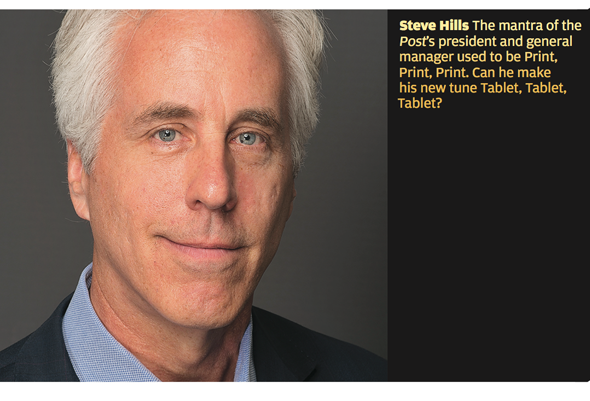
Wish list in hand, Baron, Weymouth, Steve Hills, and Shailesh Prakash, the Post‘s chief information officer and technology vice president, flew to Seattle and spent the better part of two days with Bezos and members of his team. While known for delivering cutting one-liners during meetings such as, “Does it surprise you that you don’t know the answer to that question?” Bezos was, by all accounts, gracious, and even hosted the team from the Post at his house for pancakes.
Bezos reviewed the list of proposed initiatives from the newsroom, nixing some and urging further development of others on the way to forming a new budget. Baron says he came away from the weekend in Seattle with a clear sense of what the Post‘s mission would be in the coming year: It had to have “a more expansive national vision” in order to achieve the ultimate goal of substantially growing its digital audience. Baron brought this directive back to the newsroom, and the editors set about building a plan for 2014, a year managing editor Kevin Merida dubbed “the year of ambition.” At one point in the budgeting process, Bezos even admonished the leadership for not thinking big enough. “I think that we had been in the mode of sort of watching our pennies,” Baron told me. “We were just being more cautious at the beginning so he came back with an indication that we should be more ambitious.”
A memo from Baron to the staff in January was the clearest indication of the direction in which the paper was headed. The new owner wanted to grow and think big, but not necessarily in the ways that newsrooms have traditionally done those things. The paper would maintain its investigative capacity and local reporting. But the focus of investment would be on projects with potential for massive digital growth. The origin of many of the hires could be traced to a phrase Bezos had used several times during his visit to the Post in September, when he said that the newsroom needed to “take advantage of the gifts the internet gives us.” The somewhat mystical phrase simply refers to projects that are designed to draw a disproportionate amount of traffic per journalist.
Three projects in particular fit this description. Fred Barbash, a former Post reporter and editor, was hired back to head a team of aggregator-reporters working an overnight shift to jump on stories generated by newsrooms around the world, and present them to the Post‘s readers every morning. The blog, called Morning Mix, quickly became the most popular feature on the website. Editor Justin Bank heads a similar, but smaller, team that works from 8am to midnight.
The Post also recently launched PostEverything, an online opinion section led by former National Journal executive editor Adam Kushner. While originally conceived in internal conversations as a contributor network, the idea evolved into Kushner and two assignment editors soliciting a daily torrent of essays from experts on a wide range of topics, from politics and economics to things you didn’t even realize someone could be an expert in.
Some in the newsroom see these projects as a threat to the Post‘s identity, or at the very least, a dilution of it. The local staff in particular, considered the heart of the Graham family’s paper, sensed that the organization’s momentum was shifting elsewhere. It remained the biggest staff and is not being cut. But apparently the editors and reporters had taken Bezos’ words to heart: “We can’t be in survival mode. We have to be in growth mode.”
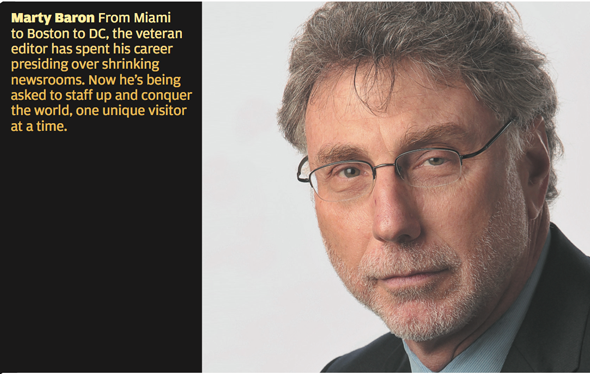
Fielding complaints in a meeting shortly after the Weymouth town hall, local editor Mike Semel told his staff that the best way for them to be included in this period of digital growth was to pitch their stories so that they’d be of interest to a national audience. One reporter argued that this would be impossible for the bulk of Metro stories. Semel agreed, but said the staff should strive to meet the needs of local readers while putting stories in a context that could gain national attention.
‘If what you’re asking is, in order to grow substantially at the national level do we have to replicate The New York Times‘ structure, the answer is no,’ Baron said.
By the end of this year, the Post will have added more than 36 new newsroom positions to its staff of roughly 600. I told Baron that it struck me that, while there had been a number of strong reporting hires, the bulk of the expansion thus far seemed to be geared toward building a Web audience rather than the ultimate goal of producing a “daily ritual” people would want in the form of a “bundle.”
“I’d say that’s fundamentally accurate,” he replied. “But there are different timeframes. There is the immediate timeframe and there’s the longer timeframe. Just because you’re doing something in the immediate timeframe doesn’t mean that you don’t have a notion as to what you might do next.”
Still, it didn’t seem like an investment meant to build a national paper in the way that The New York Times was a national paper. No one is talking about reopening domestic or foreign bureaus, for instance. Could this truly be considered an expansionist era without a desire to compete on that level? “Well, we’re in a different era. We’re in a digital era,” Baron said, before going on to list numerous hires that are beyond the “gifts of the internet” realm. There have been new reporting positions in the business section, including a reporter based in Silicon Valley, as well as hires to cover national sports and the rehiring of Post alumnus and Pulitzer Prize-winner Robin Givhan* to cover fashion. Not long after the sale, the politics staff poached star reporter Robert Costa from National Review, where he had recently won a substantial following with his coverage of the government shutdown. Existing positions are still filled with strong hires, such as National Journal‘s Ben Terris, who was brought on to write about politics for the Style section.
Then Baron said, “If what you’re asking is, in order to grow substantially at the national level do we have to replicate The New York Times structure, the answer is no.”
I asked Cameron Barr to help me understand the logic of the current expansion. “We’re clearly in Get Big Fast mode,” he said, referring to the cri de coeur of Amazon’s early years in business, when it rapidly expanded its share of the book market on the way to selling just about everything else. Another editor told me, “The logic of the current expansion is Amazonian. We’re going to get big and then figure out what to do with it.”
Other aspects of the Post are already Amazonian. Reminiscent of Bezos’ detailed involvement with designers of Amazon products like the Kindle, some of the new owner’s most frequent interactions with the Post are not with Weymouth or Hills, but considerably farther down the chain, where he checks in personally with developers working on the Post‘s new tablet app. Bezos functions almost as a chief product officer for this new effort, which has the potential to serve as an early step toward his idea of reimagining how consumers interact with news.
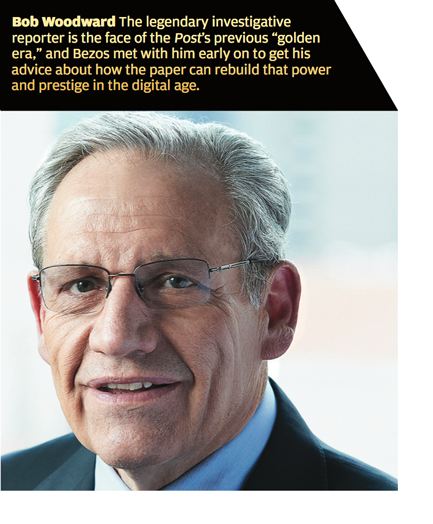
Shailesh Prakash, the chief information officer, has become an increasingly public figure in recent months, portrayed by tech-news site VentureBeat as joining Bezos at the “helm” of the Post‘s digital transformation. As with Bezos and the tablet developers, Prakash says his talks with his new boss sometimes get into the weeds: “On an as-needed basis, I definitely talk to him about product features and technology and tools on a fairly detailed level.
“It’s wonderful to have an owner who fundamentally believes that it’s not just content that will differentiate us,” he continued, “but also the design and the technology of how that content is presented, the speed at which it is presented, the quality of the products that present that content.” In other words, in most newsrooms, journalism is the engine and technology essentially functions in service of that journalism. At Bezos’ Washington Post, it seems, those two forces will find equilibrium.
This helps explain why Prakash thinks, somewhat paradoxically, that he understands what the Post needs to do better than he understands where it is going: “I don’t think any of us in the exec team or, in my opinion, Jeff himself, have prescriptive guidance on what the trajectory is. The techniques and the philosophy and the tactics to get there are more well understood.”
There’s no real outline yet for a sustainable, profitable, global-news brand to emerge from the initiatives that have been launched so far.
Bezos encouraged Prakash to open a skunk works team in New York called WPNYC, where the Post can draw from the city’s considerable tech talent pool. Here again, this is similar to the “remote development centers” Bezos set up to work on projects for Amazon. The New York office is at work on the Post‘s website redesign, as well out-of-the-box ideas for improving readers’ experience with premium advertising. Prakash also says that Bezos has invested in a “state of the art” data platform, and that he has “a couple of PhDs” working to give the paper an advantage in Big Data. Anyone interested in seeing how consumer data might be used in the hands of Jeff Bezos can go to Amazon.com and watch the company’s algorithms try to predict their desires.
This focus on data aligns with yet another distinctly Amazonian business initiative the Post has recently undertaken. Beginning in March, it announced a partner program that now gives free access to the Post‘s website and mobile apps to the subscribers of nearly 100 newspapers around the country, including The Dallas Morning News, the Minneapolis Star-Tribune, and The Denver Post. Not only does this program give the Post huge potential market penetration at very little cost, but it turns audience that might otherwise be fly-by users into logged-in, data-rich subscribers. The Post now talks of expanding the program to any type of subscription service that consumers may have, making the newspaper that was once “For and about Washington” into the high-quality, paywall-free national newspaper of every subscriber to services like Netflix or Spotify or, yes, Amazon Prime.
Plenty of change is still to come. A CEO who prides himself on thinking long-term has owned the Post for nine months, and the senior management team that led the paper during a markedly different era remains in place. As one executive at a competing media company suggested: “How can you spend $250 million on a product that is being sold to you by people who say, ‘We don’t have answers,’ and then leave it with the people who don’t have answers?”
During one of my interviews with Hills, I pressed him on a rumor I had heard that Bezos had agreed to keep him and Weymouth for one year after the sale. I told him that I wasn’t implying that this was necessarily their departure date, but wanted to know if the one-year timeline was accurate and, if so, who it applied to. He responded that the one-year offer applied to the “executive team,” and that it was actually for “calendar year 2014.” I then asked Baron if the one-year offer had been made to him. He said he never spoke to Bezos about his employment situation, and that Bezos’ encouragement to stay on as editor came to him through Weymouth. After I reached out to Baron, Hills then emailed me to “clarify” his statement, saying he had misspoke and there was never any one-year offer.
Baron gets positive reviews from nearly every journalist I interviewed for this story, on the record or otherwise. As Marc Fisher, a senior editor, put it, “Everyone can point to things that changed for the better once Marty established himself. Trying to subdivide into changes pre- and post-purchase, that’s much harder.”
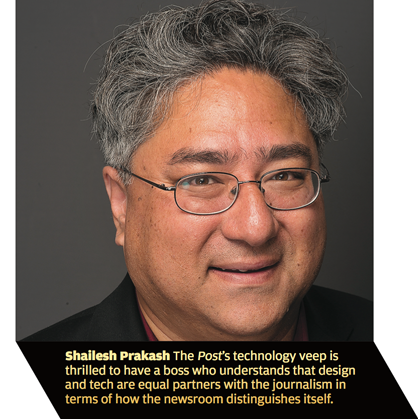
Weymouth declined to discuss her longevity at the Post, saying of Bezos that she serves “at his pleasure.” Throughout our discussion she seemed remarkably focused on the same challenges that had occupied her before the sale. I asked her what her role has been since the ownership transition and she responded, “I think from my perspective at least, it really doesn’t change. Don was my boss, whatever it was, a year ago, and obviously the board [of The Washington Post Company], and now Jeff is the owner and boss.”
“So your answer in short is . . . ?”
“I have a different boss,” she responded.
I asked her about the change in mindset a publisher must go through when turning from an environment where cuts were an inevitability to one of expansion, thinking she’d talk enthusiastically about what its like to hire again, or the promise of some new initiative. It seemed like the kind of question ripe for a ready-made response.
“I would say it’s not quite that simple,” she said. “He’s not stupid. We still have to cut costs. There’s no question that over time we still have to continue to cut costs as our business shifts from print to digital.”
Will the paper that was ‘For and about Washington’ become the national newspaper of every subscriber to services like Netflix or, yes, Amazon Prime?
She’s right, of course. Despite the almost eerie brilliance of maneuvers like the partner program, Bezos has said he’s not yet prepared for a “multi-decade” commitment. There’s no real outline for a sustainable, profitable, global-news brand to emerge from the initiatives that have launched thus far. A news bundle that people and advertisers can put their dollars behind to an extent that it sustains a 600-plus-person newsroom is at this point a dream. The printed Post may well continue to lose circulation. Its ad rates will likely continue to decline. In the meantime, the expansion will increase costs.
There’s another matter that will likely remain unknown for some time, and that is the long-term intentions of the new owner. As Fredrick Kunkle, a Post reporter and co-chair of the Washington-Baltimore Newspaper Guild, told me, “We still don’t know which Jeff Bezos we’re going to get.” Will it be the literature-loving multibillionaire who charmed the Post newsroom with fresh insights and wit and promises of runway and a new golden era? Will it be the brutal capitalist whose company seems bent on laying waste to every competitor (and even partner) in sight? In journalism’s current business environment, would the best possible scenario for the Post be a mix of both?
Steven Ginsberg, the Post‘s senior politics editor, expressed a hopeful sentiment toward the new regime that’s shared by much of the newsroom. “We aren’t being asked to undo anything,” he told me. “We’re being asked to do more of what we’d been doing. What we feel now is that we can fill out all the ambitions that we have had.”
When I spoke with managing editor Kevin Merida, he said that he felt the narrative of a “Bezos era” was overstated, both inside and outside the newsroom. A lot of changes were happening, sure, but the journalism wasn’t being done by Jeff Bezos. It was being done by The Washington Post.
I mentioned this to Baron. “I think it’s premature to declare an era when someone’s only owned the organization for seven months,” he said. “It’s kind of like we’re feeling our way and someone may look back and say, ‘That’s the beginning of the Bezos era,’ or they may look back and say, ‘I’d be hard-pressed to call that an era.’ I don’t think we can pronounce yet on if it’s a Bezos era or not.”
The better question is not how long the Bezos era will last but what can be accomplished within it.
(Disclosure: CJR’s editor in chief, Elizabeth Spayd, served as the Post‘s managing editor before joining the magazine.)
* Correction: Robin Givhan’s name was originally misspelled. CJR regrets the error.
Michael Canyon Meyer is a freelance journalist and former CJR staff writer. Follow him on Twitter at @mcm_nm.
